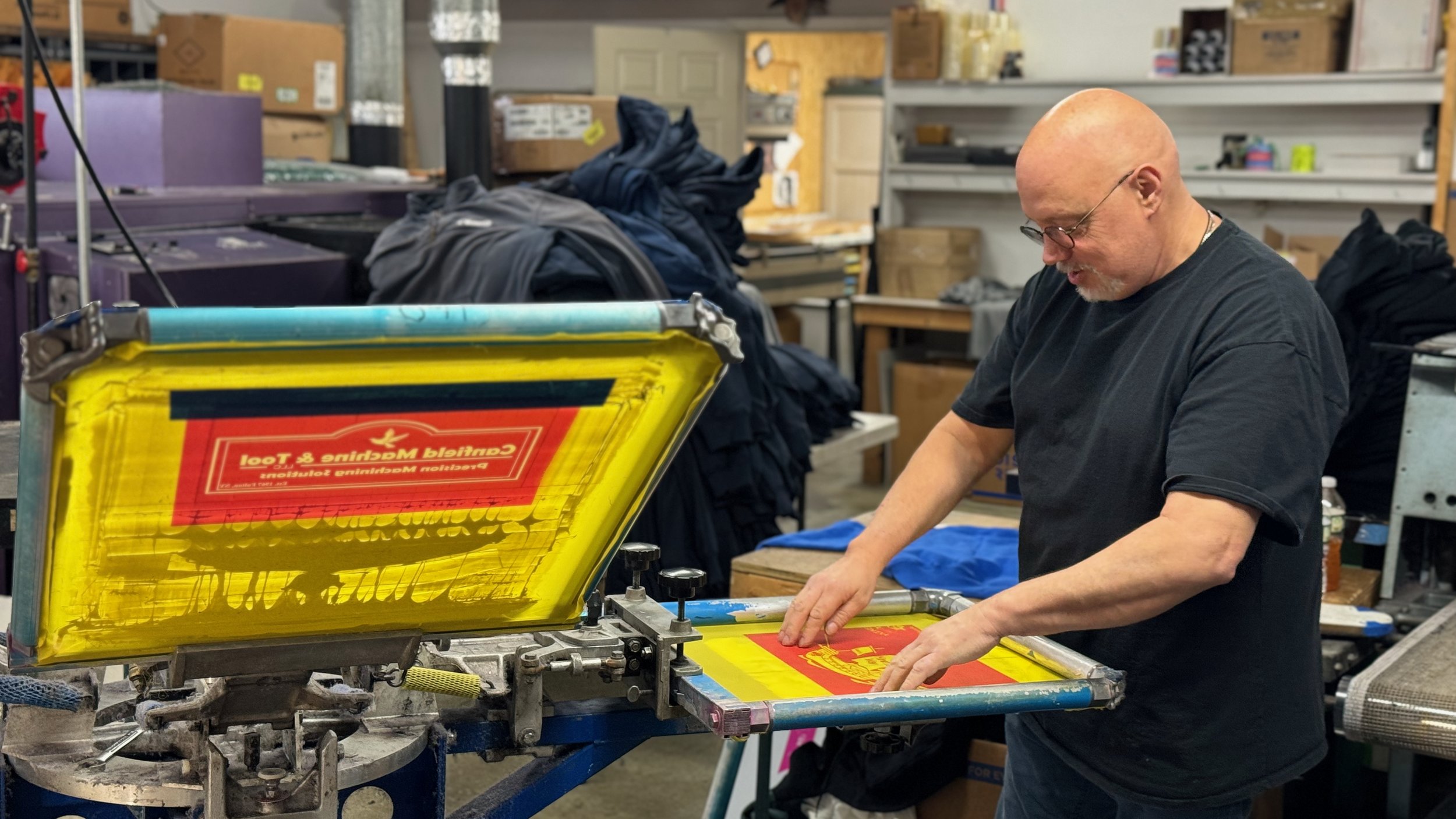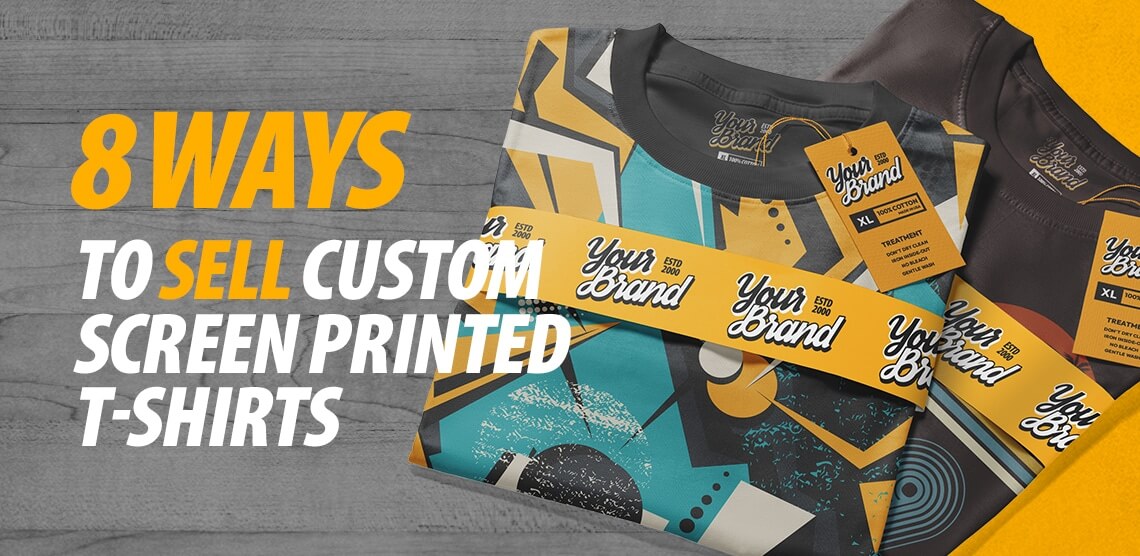Professional Screen Printing Kit for Custom Apparel
Wiki Article
Screen Printing Uncovered: Everything You Need to Know About Tee and Garment Printing Strategies
Screen printing is an interesting method that integrates art with technique, providing unlimited opportunities for imagination. Prepared to explore the crucial components that make display printing an art kind?
The Fundamentals of Screen Printing: Just How It Functions
When you plunge into screen printing, you'll uncover it's both a science and an art. At its core, display printing entails creating a stencil, or display, that permits ink to pass via only in certain locations.Position the screen over the fabric, then utilize a squeegee to press ink through the screen onto the garment. Each action is vital, and grasping them will boost your screen printing abilities, transforming simple garments right into unique, meaningful items.
Kinds of Display Printing Methods
Once you understand the fundamentals of display printing, it's time to explore the different methods that can boost your styles. One popular technique is conventional screen printing, where ink is pushed with a stenciled screen. This technique is wonderful for bold, vivid shades. There's water-based ink printing, which provides a softer feeling and is green, but it calls for a various approach to treating.If you're aiming for fine information, take into consideration discharge printing. This strategy gets rid of dye from the textile, leaving a soft, vintage appearance. Another alternative is plastisol printing, known for its toughness and brilliant shades, making it a favorite for numerous brand names. Experiment with halftone printing to develop slope impacts and elaborate designs. Each strategy has its one-of-a-kind charm, so do not wait to attempt them bent on locate what suits your design best!
Vital Equipment for Display Printing
To achieve stunning outcomes in screen printing, having the appropriate tools is basic. You'll require a tough screen printing structure, which holds the mesh that moves your layout onto the garment. Next off, invest in premium squeegees; these are essential for using ink evenly across the display.Selecting the Right Inks and Products
When selecting inks and materials for screen printing, you need to take into consideration the type of ink that functions finest for your project. Consider fabric compatibility to ensure your designs look excellent and last long. Also, explore environmentally friendly ink choices to make your printing procedure extra sustainable.Kinds Of Display Inks
Picking the right screen ink is crucial for attaining dynamic, durable prints that satisfy your project's requirements. There are a number of sorts of display inks to examine. Plastisol ink is popular for its adaptability and ease of usage, providing outstanding shade opacity on dark materials. Water-based ink, on the various other hand, offers a softer feel and is green, making it ideal for those looking to decrease their ecological influence. Discharge inks remove dye from the fabric, resulting in a soft, classic appearance yet call for specific handling. Finally, specialty inks, such as metallic or glow-in-the-dark, can include unique effects to your designs. Review your project needs and choose the ink that aligns finest with your preferred result.
Textile Compatibility Considerations
Recognizing material compatibility is important for attaining high-quality display prints, specifically considering that different products react distinctively to different inks. Constantly evaluate your inks on sample material to ensure they adhere properly and maintain shade stability. Furthermore, maintain in mind that material weight and structure can impact the final end result, so choosing the right ink and product combination is important for your project's success.Eco-Friendly Ink Options
Environmentally friendly inks are becoming a prominent option for screen printers who wish to minimize their environmental influence while preserving high quality. When choosing inks, take into consideration water-based inks, which are less harmful and simpler to clean up compared to traditional solvents. These inks bond well with materials, delivering vibrant results without hazardous chemicals. You might additionally check out eco-solvent inks that use less unstable natural substances (VOCs), making them a much safer option for both your health and the world.Additionally, search for inks made from renewable energies, such as soy or vegetable-based options. By choosing the appropriate inks and materials, you'll not just develop sensational styles yet additionally add to a much more lasting printing process. Make the button, and your prints will show your commitment to the atmosphere!
Preparing Your Layout for Display Printing

Submit Style Requirements
To assure your style looks sharp and dynamic on textile, you'll require to pay close attention to file style requirements for screen printing. Begin with vector data like AI or EPS, as they can be scaled without losing top quality. If you make use of raster photos, go with high-resolution documents, such as TIFF or PNG, preferably at 300 DPI. Avoid making use of JPEGs, as they can shed clarity when resized. Make certain your style has a clear background to avoid undesirable white edges on your prints. Lastly, maintain color settings in mind; CMYK is standard for display printing, so convert your RGB develops appropriately. By complying with these guidelines, you'll establish your art work up for an effective print.Color Separation Techniques
Shade separation is an essential action in preparing your design for display printing, and understanding it can significantly enhance your print quality. You'll need to damage your style into private shades, as each color requires a separate display throughout printing. This accuracy not only ensures accurate color representation but likewise enhances the printing process.Resolution and Size
Accomplishing the very best cause screen printing begins with guaranteeing your style has the best resolution and size. Preferably, your artwork needs to be at least 300 DPI (dots per inch) for sharp, clear prints. Your last product might look unprofessional and pixelated. if you utilize lower resolution.When it involves dimension, take into consideration the measurements of your print area. Layout your art work to match the last print size, preferably producing it in the actual measurements you'll be publishing. In this manner, you'll avoid any kind of unexpected scaling issues.
Always examine your style in both vector and raster styles. Vector graphics can be scaled without losing quality, making them suitable for display printing. Preparing appropriately will ensure your design looks remarkable on every garment!
Step-by-Step Screen Printing Process
Screen printing is a dynamic procedure that permits you to produce vivid designs on numerous surface areas. To get started, you'll require a screen, emulsion, and your chosen ink.Pour ink onto the screen and make use of a squeegee to push the ink via the pattern onto the fabric. Raise the display very carefully and allow the print dry. You have actually efficiently screen printed your layout.
Tips for Successful Display Printing Projects
While you're diving right into your screen printing jobs, keep in mind that prep work is vital to success. Start by collecting all your products-- inks, squeegees, garments, and screens. A tidy work area assists protect against unwanted mistakes, so clean prior to you start.Next, validate your artwork is high-resolution and appropriately sized for your garment. Evaluate your display for appropriate direct exposure and tidy it thoroughly to avoid smudges. When mixing your inks, adhere to the manufacturer's guidelines to achieve the ideal uniformity.
Throughout printing, use even stress with your squeegee for regular results. Do not hurry; take your time to confirm each print meets your standards. After printing, let your garments completely dry completely prior to taking care of or packaging them.
Last but not least, constantly maintain a sample of your benefit future reference. This way, you can examine your progress and improve your strategies over time. Delighted printing!

Frequently Asked Inquiries
For how long Does It Take to Establish up a Display Printing Task?
Establishing up a display printing job typically takes around 30 minutes to an hour. You'll prepare the screens, mix inks, and readjust the press. The moment differs based upon intricacy and experience, so stay organized!Can I Print on Different Fabric Enters Making Use Of the Very Same Technique?
Yes, you can print on different fabric types utilizing the very same method, but you'll require to adjust your inks and settings. Some fabrics absorb ink in different ways, so experimenting guarantees the most effective outcomes for every material.What Prevail Mistakes to Stay Clear Of in Display Printing?
When screen printing, stay clear of typical mistakes like making use of the wrong ink, neglecting appropriate direct exposure times, or avoiding pre-press checks. Always check your configuration and preserve clean screens to ensure top quality outcomes each time.Exactly How Can I Correctly Tidy and Maintain My Screen Printing Equipment?
To correctly clean and keep your display printing devices, you should regularly wash displays with ideal solvents, examine squeegees for wear, and guarantee all devices are stored completely dry and dust-free. Consistency improves and stops expensive repairs efficiency.Is Screen Printing Eco-friendly Compared to Other Techniques?
Screen printing can be more environmentally friendly than various other methods, especially if you make use of water-based inks and eco-conscious materials. By choosing lasting products and methods, you decrease waste and decrease your effect on the world.Screen Printing Uncovered: Whatever You Required to Know About Tee Shirt and Garment Printing Methods
At its core, screen printing involves developing a stencil, or screen, that enables ink to pass through just in details locations. Setting the screen over the fabric, then use a squeegee to press ink via the screen onto the garment. One preferred approach is conventional screen printing, where ink is pushed through a stenciled display.When choosing inks and materials custom screen printing for screen printing, you require to take into account the type of ink that works best for your job.
Report this wiki page